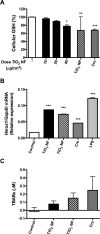Shape-Related Toxicity of Titanium Dioxide Nanofibres
- PMID: 26999274
- PMCID: PMC4801404
- DOI: 10.1371/journal.pone.0151365
Shape-Related Toxicity of Titanium Dioxide Nanofibres
Abstract
Titanium dioxide (TiO2) nanofibres are a novel fibrous nanomaterial with increasing applications in a variety of fields. While the biological effects of TiO2 nanoparticles have been extensively studied, the toxicological characterization of TiO2 nanofibres is far from being complete. In this study, we evaluated the toxicity of commercially available anatase TiO2 nanofibres using TiO2 nanoparticles (NP) and crocidolite asbestos as non-fibrous or fibrous benchmark materials. The evaluated endpoints were cell viability, haemolysis, macrophage activation, trans-epithelial electrical resistance (an indicator of the epithelial barrier competence), ROS production and oxidative stress as well as the morphology of exposed cells. The results showed that TiO2 nanofibres caused a cell-specific, dose-dependent decrease of cell viability, with larger effects on alveolar epithelial cells than on macrophages. The observed effects were comparable to those of crocidolite, while TiO2 NP did not decrease cell viability. TiO2 nanofibres were also found endowed with a marked haemolytic activity, at levels significantly higher than those observed with TiO2 nanoparticles or crocidolite. Moreover, TiO2 nanofibres and crocidolite, but not TiO2 nanoparticles, caused a significant decrease of the trans-epithelial electrical resistance of airway cell monolayers. SEM images demonstrated that the interaction with nanofibres and crocidolite caused cell shape perturbation with the longest fibres incompletely or not phagocytosed. The expression of several pro-inflammatory markers, such as NO production and the induction of Nos2 and Ptgs2, was significantly increased by TiO2 nanofibres, as well as by TiO2 nanoparticles and crocidolite. This study indicates that TiO2 nanofibres had significant toxic effects and, for most endpoints with the exception of pro-inflammatory changes, are more bio-active than TiO2 nanoparticles, showing the relevance of shape in determining the toxicity of nanomaterials. Given that several toxic effects of TiO2 nanofibres appear comparable to those observed with crocidolite, the possibility that they exert length dependent toxicity in vivo seems worthy of further investigation.
Conflict of interest statement
Figures







References
-
- Cho W-S, Duffin R, Poland CA, Duschl A, Oostingh GJ, MacNee W, et al. (2012) Differential pro-inflammatory effects of metal oxide nanoparticles and their soluble ions in vitro and in vivo; zinc and copper nanoparticles, but not their ions, recruit eosinophils to the lungs. Nanotoxicology 6: 22–35. 10.3109/17435390.2011.552810 - DOI - PubMed
-
- Donaldson K, Tran CL (2004) An introduction to the short-term toxicology of respirable industrial fibres. Mutation research 553: 5–9. - PubMed
-
- Donaldson K (2009) The inhalation toxicology of p-aramid fibrils. Crit RevToxicol 39: 487–500. - PubMed
Publication types
MeSH terms
Substances
LinkOut - more resources
Full Text Sources
Other Literature Sources
Research Materials
Miscellaneous

